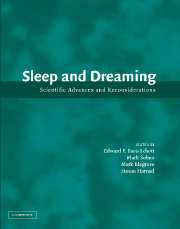Book contents
- Frontmatter
- Contents
- Preface
- Introduction
- 1 Dreaming and the brain: Toward a cognitive neuroscience of conscious states
- 2 Dreaming and REM sleep are controlled by different brain mechanisms
- 3 A review of mentation in REM and NREM sleep: “Covert” REM sleep as a possible reconciliation of two opposing models
- 4 The case against memory consolidation in REM sleep
- 5 The reinterpretation of dreams: An evolutionary hypothesis of the function of dreaming
- Open Peer Commentary and Authors' Responses
- References
- Postscript: Recent findings on the neurobiology of sleep and dreaming
- Index
Introduction
Published online by Cambridge University Press: 11 January 2010
- Frontmatter
- Contents
- Preface
- Introduction
- 1 Dreaming and the brain: Toward a cognitive neuroscience of conscious states
- 2 Dreaming and REM sleep are controlled by different brain mechanisms
- 3 A review of mentation in REM and NREM sleep: “Covert” REM sleep as a possible reconciliation of two opposing models
- 4 The case against memory consolidation in REM sleep
- 5 The reinterpretation of dreams: An evolutionary hypothesis of the function of dreaming
- Open Peer Commentary and Authors' Responses
- References
- Postscript: Recent findings on the neurobiology of sleep and dreaming
- Index
Summary
The target chapters in this book address three issues in the science of sleep and dreaming: the relationship of dreaming to brain physiology and neurochemistry and the possible functions, or lack of functions, of REM sleep and of dreaming. The target chapters provide detailed summaries of previous work and a background to these current issues. This introduction aims to summarize the main claims of each of the target chapters and to cite recent papers of relevance to those chapters that appeared around the same time as or after the production of the BBS special issue. A further update, by Edward Pace-Schott, specifically on the neuroscience of sleep and dreaming, is provided at the end of the book.
The first three target chapters of this book are concerned with the relationship between dreaming and brain physiology and neurochemistry, with particular reference to the relationship of REM sleep to dreaming. Hobson, Pace-Schott, and Stickgold detail their AIM model of the mindbrain during dreaming and other states of consciousness. This model describes three dimensions of brain neuromodulation, these being level of brain activity (A), internal or external source of stimulation for cognition (I), and mode of organization of cognition (M), which they relate to aminergic/cholinergic balance. This chapter emphasizes the importance of REM sleep to dreaming, reviews the comparison of dreaming to waking cognition [of relevance here is Kahn et al. (2000) on how character recognition occurs during dreams], and, in common with Nielsen's target chapter, reviews the history of investigations into the quantitative and qualitative differences and similarities between dreams in REM and NREM sleep.
- Type
- Chapter
- Information
- Sleep and DreamingScientific Advances and Reconsiderations, pp. xi - xivPublisher: Cambridge University PressPrint publication year: 2003

